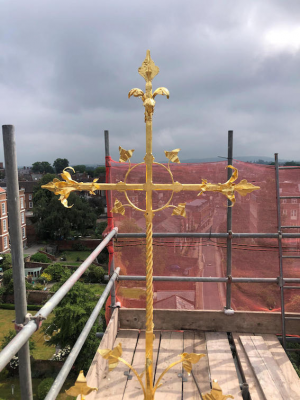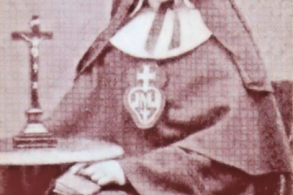Arts and Crafts Cross returned to roof of Shrewsbury Cathedral

A stunning wrought iron cross has been restored and returned to the roof of Shrewsbury Cathedral, on the same day that the mother church of the Diocese re-opened for to the public for private prayer. The cross, which adorns the bell tower, is a fine example of the early work of the Arts and Crafts movement that was anticipated by Augustus Welby Pugin, the architect who designed the Cathedral.
The cross was installed in 1856, the year the Cathedral was first opened, and was in dire need of restoration because of rusting and damage, having never been taken down and repaired for more than one-and-a-half centuries. It was removed for the first time since its installation to be repaired and repainted by M Salt Limited, a conservation specialist who this year also undertook a project to repair and restore 'John Henry', the Cathedral bell.
The Rt Rev Mark Davies, Bishop of Shrewsbury, said: "In this year of global pandemic, it seems especially appropriate to see the Cathedral Cross restored as the sign of hope in the victory of life and love. Raised high above the Cathedral, this cross that will continue to shine on the skyline of Shrewsbury for generations to come."
There is no documentary evidence to show who designed and commissioned the cross though architects suspect it was AW Pugin's son, Edward, who took the responsibility to finish the Cathedral after the death of his father in 1852, working together with John Hardman Powell, who supplied the metalwork to other parts of the church, including the font cover, tabernacle, high altar crucifix and six candlesticks.
Mike Salt of M Salt Ltd said he believes the cross "is a lovely example of Arts and Crafts work", not only in its design but because it uses wrought iron for the main body with charcoal iron to form ornate acanthus leaves and water (ivy) leaves. He suggested that the forging and use of charcoal iron points to the cross being an example of the revival of the repoussé work of the 17th century, the so-called golden age of British blacksmithing under the inspiration of Jean Tijou, a French ironworker who created much of the ornamental metal work for Hampton Court Palace in that century.
One of the main objectives of the Arts and Crafts movements was to rediscover and revive lost practices, among them ornamental blacksmithing and repousse, a technique of creating patterns by hammering metal on the reverse side.
Mr Salt said: "In my mind therefore, the cross is historically important not only because it demonstrates the best in the movement, but also because it demonstrated that it was still possible to reproduce Tijou's work in a modern environment. I would like to think that its repair and conservation has continued that theme."
LINK
Diocese of Shrewsbury - www.dioceseofshrewsbury.org





















